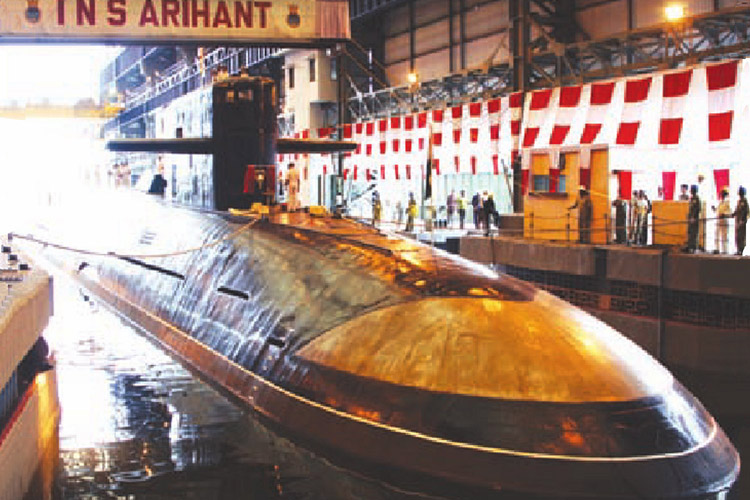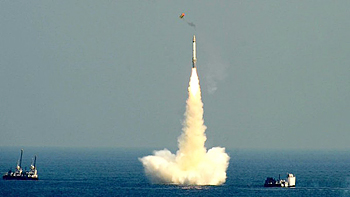INDIAN ARMED FORCES CHIEFS ON OUR RELENTLESS AND FOCUSED PUBLISHING EFFORTS

The insightful articles, inspiring narrations and analytical perspectives presented by the Editorial Team, establish an alluring connect with the reader. My compliments and best wishes to SP Guide Publications.

"Over the past 60 years, the growth of SP Guide Publications has mirrored the rising stature of Indian Navy. Its well-researched and informative magazines on Defence and Aerospace sector have served to shape an educated opinion of our military personnel, policy makers and the public alike. I wish SP's Publication team continued success, fair winds and following seas in all future endeavour!"

Since, its inception in 1964, SP Guide Publications has consistently demonstrated commitment to high-quality journalism in the aerospace and defence sectors, earning a well-deserved reputation as Asia's largest media house in this domain. I wish SP Guide Publications continued success in its pursuit of excellence.
- Prime Minister Modi Visits Punjab’s Adampur Air Base, Interacts with Airmen after Successful ‘Operation Sindoor’; Stern Message to Pakistan
- The layered Air Defence systems that worked superbly, the key element of Operation Sindoor
- Operation Sindoor | Day 2 DGMOs Briefing
- Operation Sindoor: India strikes back with Precision and Purpose
- Operation Sindoor: Resolute yet Restrained
- India’s Operation Sindoor Sends a Clear Message to Terror and the World – ‘ZERO TOLERANCE’
- Japan and India set forth a defence cooperation consultancy framework, talks on tank and jet engines
- Terrorist Attack in Pahalgam in Kashmir: Unfolding a long surgical war against PAK
- Lt General Pratik Sharma takes over Command of Indian Army's Northern Command
BARC to build Submarine Nuclear Reactor in India
The Bhabha Atomic Research Centre (BARC) is set to build a new 190-MW submarine nuclear reactor, marking a pivotal advancement in the country's nuclear and maritime capabilities. The reactor will power P77 nuclear attack submarine-- SSN and S-5 ballistic missiles nuclear submarines --SSBN. This critical tech for national security comes at a time when China has succeeded in building a land-based prototype nuclear reactor for a large surface warship.

In a significant development for India's defence and energy sectors, the Bhabha Atomic Research Centre (BARC) is set to build a new 190-MW submarine nuclear reactor, marking a pivotal advancement in the country's nuclear and maritime capabilities. The reactor will power the P77 nuclear attack submarine–Ship Submersible Nuclear (SSN) and S-5 ballistic missiles nuclear submarines –Ship Submersible Ballistic Nuclear (SSBN) that carry nuclear warheads. India has planned for six SSNs under Project 75 Alpha.

This comes at a time when China has succeeded in building a land-based prototype nuclear reactor for a large surface warship. China is advancing toward producing the country's first nuclear-powered aircraft carrier, according to a new analysis of satellite imagery and reports.
After INS Arihant, the Navy has already inducted a second ballistic missile nuclear submarine (SSBN) – INS Arighat – codenamed S-3. Both submarines weigh about 6,000 tonnes, are powered by an 83 MW pressurised water reactor, and are armed with K-15 nuclear ballistic missiles, which have a range of 750 km.
Additionally, the third SSBN, slightly larger, 7,000-tonne, INS Aridhaman is in the pipeline for the commission by the next year. INS Arighat will be loaded with K-4 submarine-launched ballistic missiles (SLBMs) with a range of 3,500 km. The Navy has further planned for SSBN, the S-4, and an unnamed fifth SSBN with the 5,000-km range K-5 submarine-launched ballistic missile (SLBM).
The Bhabha Atomic Research Centre (BARC) is set to build a 190-MW nuclear reactor for India's P77 nuclear attack submarines (SSN) and S-5 ballistic missile nuclear submarines (SSBN), marking a pivotal advancement in India's defence and maritime capabilities.
This move comes at a time when India's strategic and defence interests are evolving rapidly, and its ambitions for self-reliance in advanced technology have never been clearer. The creation of an indigenous nuclear reactor for submarines is poised to further bolster India's naval strength and establish it as a key player in the global defence arena.
The Role of BARC in India's Nuclear Programme
Founded in 1954, the Bhabha Atomic Research Centre (BARC) has been the linchpin of India's nuclear energy and defence programmes. As the primary research and development organisation for India's civilian and military nuclear sectors, BARC has been instrumental in developing indigenous nuclear technology, including reactors, fuel cycles, and weapons-grade material. The centre has also played a vital role in India's nuclear submarine programme, which forms the backbone of the country's strategic deterrence capability.
The Significance of a Submarine Nuclear Reactor

A nuclear-powered submarine (SSN or SSBN) relies on nuclear reactors to generate the power required to propel it underwater for extended periods without needing to surface for fuel. This is a critical advantage, as it allows submarines to remain submerged for months, making them difficult to track and capable of carrying out sustained operations without logistical constraints.
India has long sought to develop and deploy such technology to enhance its strategic deterrence capabilities. Nuclear-powered submarines, particularly those carrying ballistic missiles (SSBNs), are considered the ultimate deterrent against adversaries due to their stealth and the assured retaliation capability they offer in the event of a nuclear conflict.
India has planned for six nuclear attack submarines under Project 75 Alpha, enhancing its strategic naval strength amid growing regional tensions.
A closer look at the two fronts gives the urgency to not only scale up the deterrence but also the strike capability. There are serious concerns on both fronts especially in this area of strategic deterrence and strike capability. Pakistan has acquired eight Chinese Type 039B Yuan-class submarines – with the first of the class launched in April this year.
China's People's Liberation Army -Navy (PLAN) fleet has acquired 60 submarines, including six SSBNs, 6 SSNs, and 48 diesel-electric submarines with two new classes of nuclear submarines-- the Type 95 SSN and the Type 96 SSBN underway. The concern is acute for India as the PLAN may even come close to the massive strength US Navy, which has 68 nuclear submarines (14 SSBNs, four SSGNs, and 49 SSNs).
India's Nuclear Submarine Programme: A Timeline

India's journey towards developing nuclear-powered submarines has been both challenging and ambitious. The country's first indigenously designed nuclear-powered submarine, INS Arihant, was launched in 2009 and became operational in 2016 after completing rigorous sea trials. This marked a major milestone in India's defence history, positioning the nation as one of the few countries in the world with a nuclear triad, the ability to launch nuclear weapons from land, air, and sea.
However, INS Arihant's reactor was initially based on a design borrowed from Russia, specifically the VM-4 reactor, a technology developed in the Soviet era for their submarines. While this was a significant leap forward, India's long-term goal is to develop an indigenous nuclear reactor for submarines that meets both its security and technological needs.
India's indigenous nuclear submarine programme signifies a major step toward self-reliance in defence technology, with the new reactor project expected to enhance the operational capabilities of India's next-generation submarines
BARC and the Development of Indigenous Submarine Nuclear Reactors
The new initiative by BARC to design and construct a submarine nuclear reactor represents a crucial step towards achieving greater self-reliance in defence technology. This development will likely involve advanced reactor designs that meet the unique operational demands of submarines, including compact size, efficiency, and durability. The reactor will also need to withstand the harsh underwater environment, including pressure and vibration, all while ensuring that it remains safe and sustainable for long-duration missions.
The reactor design for these submarines will likely build on the technology demonstrated by the Arihant-class submarines but take it a step further by creating an even more sophisticated and efficient power source. In particular, the Pressurized Water Reactor (PWR), which is currently being used in India's nuclear-powered submarines, will likely see upgrades, potentially incorporating newer safety features, increased fuel efficiency, and reduced maintenance requirements.
The Indo-Pacific region's rising geopolitical tensions make India's ability to project naval power increasingly crucial, and BARC's nuclear reactor development aligns with India's broader maritime ambitions and strategic deterrence goals
The Future of India's Naval Power
The new reactor project is likely to accelerate the development of India's next-generation nuclear-powered submarines, which could include the Arihant-class's successor, the SSBN class, as well as potential new submarines focused on attack missions (SSNs). The addition of more submarines to India's fleet will allow the Navy to maintain a continuous deterrent patrol, ensuring that India's second-strike capability remains credible and effective.
In between, addressing the gaps as an interim measure in SSN capability, India is also geared up to lease an Akula-class submarine, INS Chakra III, from Russia which is delayed and expected to be delivered by 2025.
The development also has broader implications for India's maritime ambitions. With increasing global geopolitical tensions and the Indo-Pacific region becoming a focal point of international strategic competition, India's ability to project power through its naval assets will be crucial for both regional and global security.
The construction of an indigenous submarine nuclear reactor by BARC is not only a leap forward in technological terms but also a significant step in strengthening India's strategic deterrence capabilities. By increasing the number of nuclear-powered submarines, India can ensure the survivability of its nuclear arsenal in case of a first-strike attack from a potential adversary.
The construction of an Indigenous submarine nuclear reactor by BARC is a landmark development for India's defence infrastructure, signalling a new phase in the nation's technological and strategic evolution. With this initiative, India not only enhances its self-reliance in critical defence technologies but also ensures that its strategic deterrence remains credible in the face of evolving threats. As India continues to modernise its military and expand its global influence, this breakthrough in submarine nuclear technology will serve as a cornerstone of its naval and national security strategy in the 21st century.
Manish Kumar Jha is a Consulting & Contributing Editor for SP's Aviation, SP's Land Forces and SP's Naval Forces and a security expert. He writes on national security, military technology, strategic affairs & policies.





